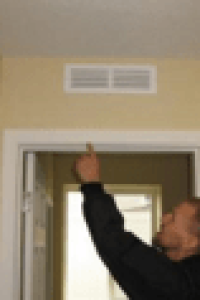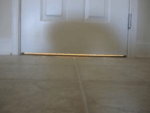HVAC Balancing Techniques
ENERGY STAR®
Checklist
Transfer Grilles

Comments:
The purpose of these balancing techniques is to provide for pressure balancing between the bedrooms and the rest of the house.
Install ducted returns or a combination of ducted returns, transfer grilles, jump ducts, and/or door undercuts in bedrooms to allow pressure balancing between bedrooms and the rest of the house in homes with ducted heating and cooling systems by providing a path for room air to return to central air handler thereby increasing the volume of conditioned air circulating in the room.
EnergyStar® Certified Home requires that the dedicated return ducts, transfer grilles, jump ducts, and/or door undercuts together achieve a rater-measured pressure differential of ≤3 Pascals (0.012 inch water column) with respect to the main body of the house when bedroom doors are closed and the air handler is operating on the highest design fan speed. A rater-measured pressure differential of ≤5 Pascals (0.020 inch water column) is acceptable for rooms with a design airflow ≥150 cfm.
If transfer grilles or jump ducts are used, refer to the balancing report provided by the HVAC contractor for the bedroom air flows to size the grilles or ducts. If a balancing report was not provided, the flow of the supply register when the air handler is on high speed may need to be measured using a flow hood, anemometer, or other flow measurement tool. Ensure that both openings have the required free area. Seal all seams, gaps, and holes in the ducts and connections
If dedicated return ducts are installed in each bedroom, contractors must seal all seams, gaps, and holes of the return duct system with mastic and seal the return box to the floor, wall, or ceiling with mastic, caulk, and/or foam.
Test the pressure differential with the bedroom doors closed.

